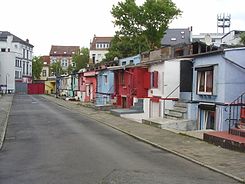Helenenstrasse (Bremen)
| Helenenstrasse | |
|---|---|
| Street in Bremen | |
| Basic data | |
| city | Bremen |
| district | Eastern suburb |
| Created | 1878 |
| Cross streets | In front of the stone gate |
| use | |
| User groups | pedestrian |
| Road design | Pedestrian street |
The Helen Street in the village of stone gate in the eastern suburbs in Bremen is since the 19th century the prostitution serving street.
Establishment
The building contractor Carl Philip Weiland erected the building on today's Helenenstraße , originally planned by him as a cul-de-sac between the streets Steintor and Auf der Kuhlen . As the widow Helene Engelken denied him the sale of its land, the road was only as from the street in front of the stone gate outgoing impasse are running. It is the only real dead end in the so-called quarter of Bremen. The building contractor therefore named the street, which he did not want as a cul-de-sac, after the widow's first name. As was common in Bremen at the time, Helenenstrasse was built with old- style buildings in the Wilhelminian style .
Designation as a brothel street
Shortly after construction, the street was designated as a brothel street by a decree of the Senate of Bremen in 1878 . Prostitution should take place in the Hanseatic city in the form of "controlled and regulated prostitution". The prostitutes were registered and a police station was set up at the entrance to the street to avoid pimping . The main purpose of the facility was to prevent the spread of sexually transmitted diseases in Bremen. Therefore, strict emphasis was placed on the use of condoms and medical supervision. The buildings were equipped with toilets and there was a bathing room. The police regulations forbade the "control whores" from addressing or attracting men outside the street, they were not allowed to visit theaters or museums, keep dogs or cats and not even enter the park at Wallgraben or the Bürgerpark . Despite the strict regulations, there were protests against the establishment of Helenenstrasse; a petition against this institution with 2,200 signatures was submitted as early as 1879 , but this did not lead to any change.
Helenenstrasse was the first controlled brothel zone in what was then the German Empire . The Senate and State Councilors of Bremen were proud of this unique facility. The Senate even made a wooden model of Helenenstrasse and presented it at international health fairs.
Temporary prohibition of prostitution
In 1926, under pressure from the Bremen women's movement , communist and social democratic MPs, prostitution in the street was prohibited by law by the Bremen citizens . The Helenenstrasse was renamed Frankenstrasse. Since many of the prostitutes in Helenenstrasse had meanwhile become the owners of the houses, prostitution was now continued illegally in Helenenstrasse. Under the rule of the National Socialists , prostitution in Helenenstrasse was allowed again in 1934 and the street was renamed Helenenstrasse again in 1936. During the Second World War , this street was also seriously damaged by British air raids . In contrast to the rest of the city, the damage has not yet been completely repaired.
Reduction of brothel prostitution
While around a hundred women worked in the street at the wedding on Helenenstrasse, today there are only around half. The competition from Eastern European forced prostitutes , other street prostitution , especially drug prostitution and apartment prostitution has significantly reduced the volume of business in this street. Some of the rooms are empty, which has already led to leasing to private individuals and has significantly reduced the value of the houses on Helenenstrasse.
Despite the significantly reduced sales in Helenenstrasse since the beginning of the 21st century, the Advisory Board of the Eastern Suburb rejects a conversion of the red light district. In the opinion of the advisory board, dismantling the privacy screens at the entrance to the street would also not make sense. Prostitution would then for street prostitution relocate and in private homes. This would make police surveillance more difficult and encourage trafficking and pimping.
See also
Web links
- Kai Schöneberg, From "Controlling Dirnen" to the Sex Ghetto , taz-Bremen from April 27, 2002
- Private tenants on Helenenstrasse, radio and television report from Radio Bremen ( Memento from May 1, 2010 in the Internet Archive )
Individual evidence
- ↑ Barbara Debinska, The Helenenstrasse Today and Tomorrow , Weser-Kurier of November 17, 2011.
Coordinates: 53 ° 4 ′ 20 " N , 8 ° 49 ′ 35" E
